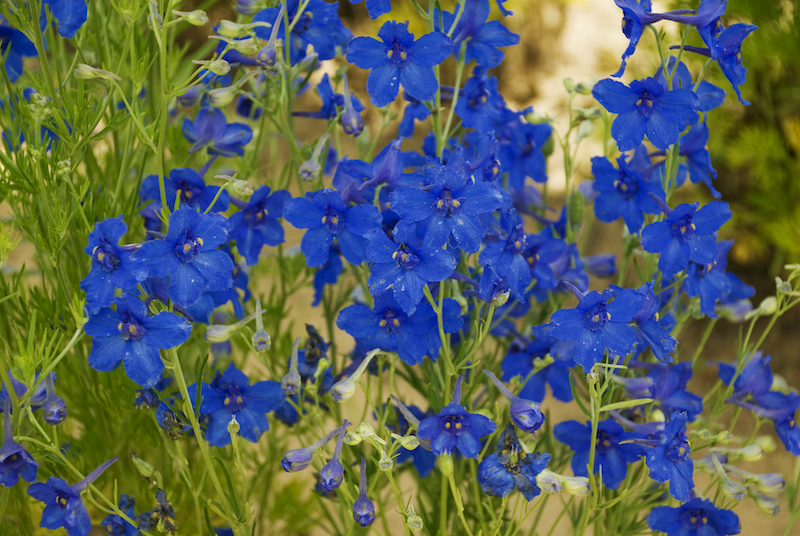Larkspurs are some of the earliest blooming and most exceptional flowers in the ornamental garden. The flower spikes can reach 4 feet tall on some cultivars and are packed with blooms. Larkspur are also very hungry plants. They need a good supply of nutrients to be able to produce the copious amounts of flowers and growth that make them the star of the late spring and early summer garden. Larkspur requires feeding at key times during the growing season, which will support this vigorous growth.

How to Fertilize Larkspur
Larkspur, also known as Delphinium, prefers soil that is well drained and in the neutral range of the pH scale, 6.5-7.0. All soil textures are acceptable, although perennial types of larkspur are shorter lived when planted in heavy clay soils. There are three key times to feed Larkspur. The first is early in the spring as new growth appears. A balanced slow-release granular fertilizer should be spread on the soil around the root zone.
Lightly scratching the food in the soil and then giving the plant a good watering will help the fertilizer dissolve and become accessible to the roots. The next feeding will be just as the flower spikes appear and then again about 6 weeks later to encourage another flush of blooms late in the summer.

Best Time To Fertilize Larkspur
Even fertilization of Larkspur keeps the plant growing healthy and helps keep the stems sturdy. The first feeding of the year should include a balanced fertilizer that has an equal ratio of N-P-K. A 10-10-10 fertilizer will provide enough Nitrogen for leaf growth while also supporting flowering and root growth with Phosphorus and Potassium. The other 2 feedings should be a fertilizer blended for flowering plants.
The ratio of N-P-K should approximate 5-12-5, where Phosphorus is the higher number. Rose fertilizer or even Tomato feed works well. All fertilizing needs to stop by the beginning of August. Larkspur needs time to harden off and prepare for winter dormancy.

Best Fertilizer For Larkspur
Slow-release fertilizer should be applied at the first feeding. A balanced mix that has an equal ratio of N-P-K is a good start for the growing season. Plant Tone by Espoma or Lily Miller All Purpose Plant Food are examples of a 10-10-10 formula. The last two feedings can be done with either a granular fertilizer or liquid formulation. Since these two feedings are primarily to support flowers, fertilizers labeled for Roses or Tomato/Vegetable plants will have the right blend for robust and repeat blooming. Fertilizers labeled for Tomato and Roses will have a higher P number and a low N number.
Larkspur Fertilizing Tips
- Larkspur are heavy feeders that need consistent feeding to support blooming
- Feed with a balanced fertilizer as new growth emerges early in the spring
- Feed as the first round of flower spikes are forming with a fertilizer formulated for Roses or Tomatoes
- Feed one last time after the first round of blooms has finished, encouraging a flush of blooms later in the summer
Warnings
-Always wear protective gloves and a face mask when handling chemical fertilizers.
-Closely follow all directions and storage guidelines that are on the fertilizer label.
 |
Author Robbin Small - Published 8-22-2022 |
